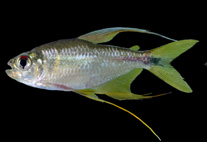Abstract
We describe a new species of Amerotyphlops from an upland forest enclave in the state of Paraíba, Northeastern Brazil. The new species is distinguished from the other seven South American species of Amerotyphlops by the combination of the following characters: nasal suture incomplete; rostral scale oval and yellowish cream with some dark brown spots; four supralabial scales; three infralabial scales; rows of scales around the body 18/18/18; middorsal scales from 204 to 225; dorsum with twelve to thirteen rows of scales dark brown and belly with four to five rows of scales immaculate yellowish cream; caudal spine dark brown; subcaudal scales 8–10 in female and 11–13 in males; maximum total length 233 mm. The new species is morphologically similar to A. amoipira and A. paucisquamus, sharing 18/18/18 rows of scales around the body and a small overlap of counts of middorsal scales.

